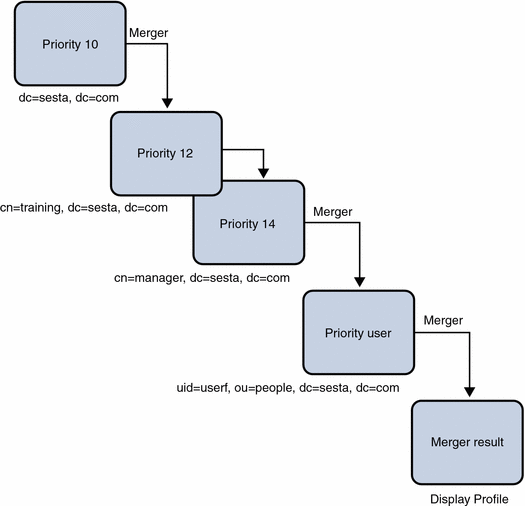Introduction
The display profile is composed of a hierarchy of XML documents. The software can store a display profile document for the user, each role the user belongs to, and the user’s organization or suborganization. At runtime, the system merges these multiple display profile documents to deliver a particular portal desktop to the user. This process of merging display profile documents affects the final display profile by potentially changing channel, provider, and property definitions.
The display profile data format contains syntax that defines how these documents are combined. This definition is commonly known as merge semantics.
Merge semantics control how attributes are combined as display profile documents from different LDAP nodes (base DN, DN, and role DNs) which are merged to form a single representation (that is, Desktop). Merge semantics assume an ordering to display profile documents. The Sun Java System Portal Server 7.1 software imposes an additional ordering on Sun Java System Access Manager software roles to simulate a hierarchical structure.
The set of display profile documents for a user consists of: the documents that exist at the user’s LDAP organization and suborganization nodes; the documents that exist at each of the user’s role nodes; and the document that exists at the user’s entry node. Documents do not need to be defined at each of these nodes, but there must be at least one document defined at a node. The set of documents is sorted according to a priority value that the display profile document defines. See Display Profile Document Priorities for more information.
You can visualize the process of document merging as laying one display profile document on top of another. A merge happens where like named channels, providers, and properties fall on top of one another. Merging is based on the name of the display profile object, not the XML structure defined in the display profile document. Like named channels can exist in different containers within the containment hierarchy in the display profile to be merged.
For example, Figure 18–1 shows a sample DIT with each level having its own display profile document. At the top of the tree is the global display profile. Next is the base DN, dc=sesta,dc=com. It has a two role DNs, training and manager. The tree ends at the uid DN, user1. Each node in the DIT has its own display profile document. The resultant display profile document is produced through a merge of all the display profile documents, based on their priorities. This merge result is presented to the user at login. Merge semantics control how display profile documents are combined. These semantics include replace, remove, and fuse. Display profile objects can also be locked. During the merge, a higher priority document can lock a display profile object to prevent a lower priority document from altering it.
Figure 17–1 Example of Merge Process

- © 2010, Oracle Corporation and/or its affiliates
